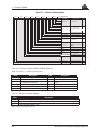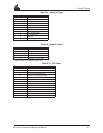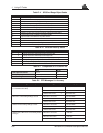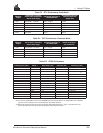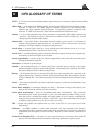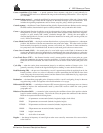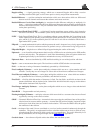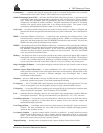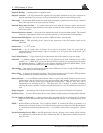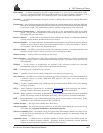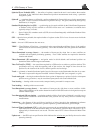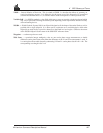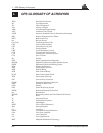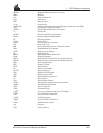
K GPS Glossary of Terms
MiLLennium Command Descriptions Manual 245
PRN number — a number assigned by the GPS system designers to a given set of pseudorandom codes.
Typically, a particular satellite will keep its PRN (and hence its code assignment) indefinitely, or at
least for a long period of time. It is commonly used as a way to label a particular satellite.
Pseudolite — an Earth-based transmitter designed to mimic a satellite. May be used to transmit differential
corrections.
Pseudorange — the calculated range from the GPS receiver to the satellite determined by taking the difference
between the measured satellite transmit time and the receiver time of measurement, and multiplying
by the speed of light. This measurement generally contains a large receiver clock offset error.
Pseudorange Measurements — measurements made using one of the pseudorandom codes on the GPS
signals. They provide an unambiguous measure of the range to the satellite including the effect of
the satellite and user clock biases.
Receiver channels — a GPS receiver specification which indicates the number of independent hardware
signal processing channels included in the receiver design.
Reference Satellite — in a double difference implementation, measurements are differenced between different
satellites on one receiver in order to cancel the clock bias effect. Usually one satellite is chosen as
the “reference”, and all others are differenced with it.
Reference Station — the GPS receiver which is acting as the stationary reference. It has a known position and
transmits messages for the "remote" receiver to use to calculate its position.
Relative bearing — bearing relative to heading or to the vessel.
Remote Receiver — the GPS receiver which does not know its position and needs to receive measurements
from a reference station to calculate differential GPS positions. (The terms remote and rover are
interchangeable.)
Residual — in the context of measurement, the residual is the misclosure between the calculated
measurements, using the position solution and actual measurements.
RMS — root-mean-square, a probability level of 66%.
Route — a planned course of travel, usually composed of more than one navigation leg.
Rover Receiver — the GPS receiver which does not know its position and needs to receive measurements from
a reference station to calculate differential GPS positions. (The terms rover and remote are
interchangeable.)
RT-20 — NovAtel’s Double Differencing Technology for real-time kinematic (RTK) carrier phase floating
ambiguity resolution.
RTCA — Radio Technical Commission for Aeronautics, an organization which developed and defined a
message format for differential positioning. See Appendix F for further information.
RTCM — Radio Technical Commission for Maritime Services, an organization which developed and defined
the SC-104 message format for differential positioning. See Appendix F for further information.
RTK — real-time kinematic, a type of differential positioning based on observations of carrier phase. In this
document it is also used with reference to RT-2 and RT-20.
Satellite elevation — the angle of the satellite above the horizon.
Selected waypoint — the waypoint currently selected to be the point toward which the vessel is travelling.
Also called "to" waypoint, destination or destination waypoint.
Selective Availability (SA) — the method used by the United States Department of Defence to control access
to the full accuracy achievable by civilian GPS equipment (generally by introducing timing and
ephemeris errors).
Sequential receiver — a GPS receiver in which the number of satellite signals to be tracked exceeds the
number of available hardware channels. Sequential receivers periodically reassign hardware
channels to particular satellite signals in a predetermined sequence.




